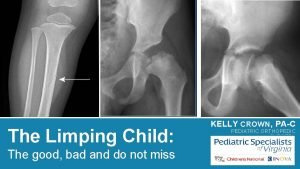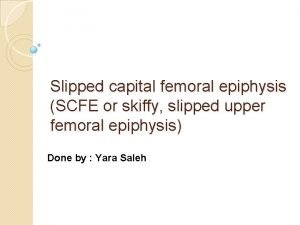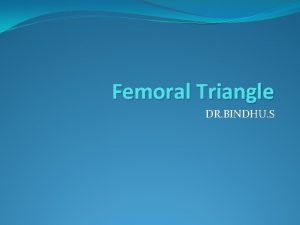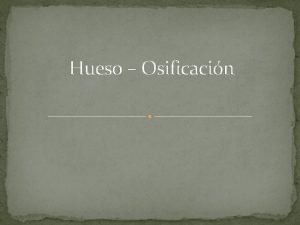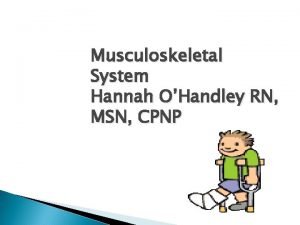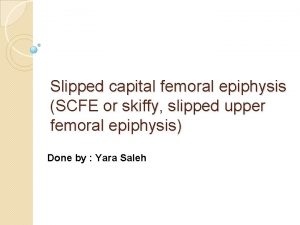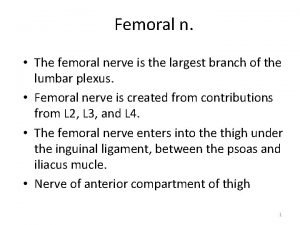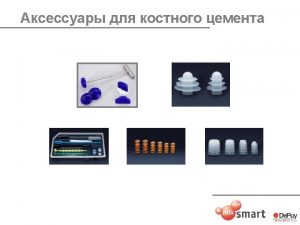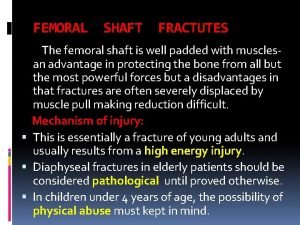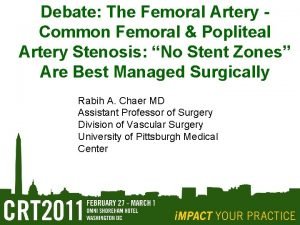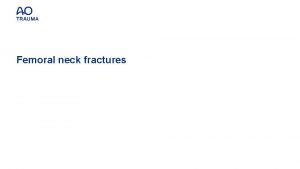Slipped capital femoral epiphysis SCFE or skiffy slipped















- Slides: 15

Slipped capital femoral epiphysis (SCFE or skiffy, slipped upper femoral epiphysis) Done by : Yara Saleh

outlines 1 - Definition 2 -Epidemiology 3 -Presentation 4 -Clinical features 5 -Diagnosis 6 -Complications 7 -Treatment

*normally a growing femur has 4 main parts : 1 - diaphysis 2 -metaphysis 3 - growth plate also called physis 4 -epiphysis *The cartilaginous growth plate has cells that divide and enable the bone to grow in length , these cells are very active in adolescents and they enable a growth spurt *During this period a growth plate is very weak and vulnerable to shearing force *Before the growth plate is ossifies it supported by perichondrial ring which is CT that extends from metaphysis to the epiphysis , it helps resist the shearing forces so the femoral head and neck don’t slip away from each other * Eventually the cartilaginous growth plate ossifies and fuse with epiphysis

Definition �SCFE is the most common hip disorder in adolescence. �SCEF is a medical term referring to a fracture through the growth plate (physis), which results in slippage of the overlying end of the femur (epiphysis) from the femoral neck caused by weakness of the perichondral ring. �The femoral epiphysis remains in the acetabulum, while the metaphysis move in an anterior direction with external rotation.


Epidemiology � Boys are affected more often than girls. � SCFEs often occur in : 1 -In obese children 2 -males (male to female ratio is 2: 1. 4) 3 -during period of rapid growth (10 -16 years of age) � Two-thirds of the patients are overweight and sexually under-developed, or unusually tall and thin. � If one side slips there is a 30% risk of the other side slipping as well.

Presentation *Chronic (>3 weeks): most common - Aching groin, hip, thigh or knee pain and limp - - Often no history of trauma *Acute (<3 weeks): severe hip pain, inability to walk usually after trauma *Minor vs moderate vs. severe depends on displacement of epiphysis in relation to the diameter of the femoral neck. -Minor displacement: displacement of less than one-third the width of the epiphysis -Moderate displacement: displacements of one third to one-half the epiphyseal width - Severe displacement: if the displacement is more than one-half the epiphyseal width

Clinical features �The patient presents with gradual, progressive onset of pain in the groin, the anterior part of the thigh or the knee (referred pain); he may also limp. �On examination the leg is externally rotated and is 1 or 2 cm short. Characteristically there is limitation of abduction and medial (internal) rotation. Following an acute slip, the hip is irritable and all movements are accompanied by pain.

Diagnosis By pelvic Xray *AP radiograph: Klein line is a line drawn along the superior border of the femoral neck that would normally pass through a portion of the femoral head. If not, slipped capital femoral epiphysis is diagnosed. → Trethowan's sign


* Frog leg radiograph: Is diagnostically more reliable; even minor degrees of slip can be shown by drawing lines through the base of the epiphysis and up the middle of the femoral neck – if the angle indicated is less than 90 degrees, the epiphysis has slipped posteriorly. -note : �A straight line through the center of the femoral neck proximally should be at the center of the epiphysis. If not, and the line is anterior in the epiphysis, it is likely an SCFE.


Complications 1 -Slipping at the opposite hip occurs in one-third of cases. 2 -Avascular necrosis is the most serious complication. 3 -Coxa vara deformity may result if the displacement is not reduced and the epiphysis fuses in its deformed position. The patient limps but the condition is usually painless. Osteotomy may be needed to correct the deformity. 4 - Secondary osteoarthritis is a likely sequel if displacement has not been reduced, and inevitable if there has been avascular necrosis.

Treatment - Surgery, either In situ fixation using screws or osteotomy if there's deformity. - Closed reduction is dangerous and should not be attempted

Thank you
 Legg calve perthes disease vs scfe
Legg calve perthes disease vs scfe Scfe schoology
Scfe schoology Skiffy hip injury
Skiffy hip injury Femoral triangle boundaries
Femoral triangle boundaries Femoral canal and femoral sheath
Femoral canal and femoral sheath Parts of a growing long bone
Parts of a growing long bone Epiphysis and diaphysis
Epiphysis and diaphysis Vertebral column labeled
Vertebral column labeled Epiphyseal plate
Epiphyseal plate Bryant traction
Bryant traction Stable fracture
Stable fracture The upper epiphysis unites with the shaft
The upper epiphysis unites with the shaft Epiphysis fuga
Epiphysis fuga Breaks in earth's crust where rocks slipped past each other
Breaks in earth's crust where rocks slipped past each other Dgp week 17
Dgp week 17 If you were grammar
If you were grammar
